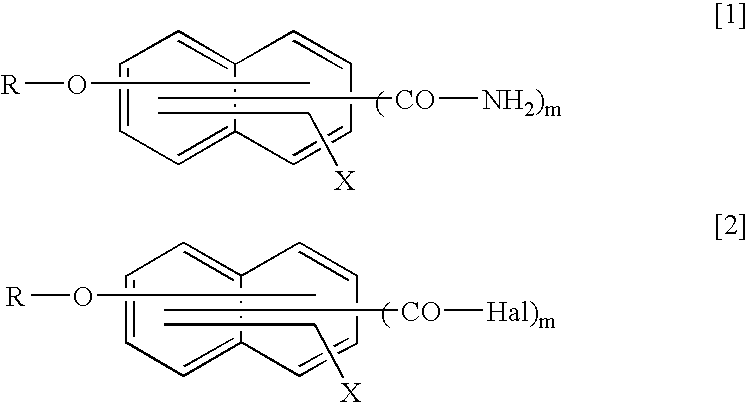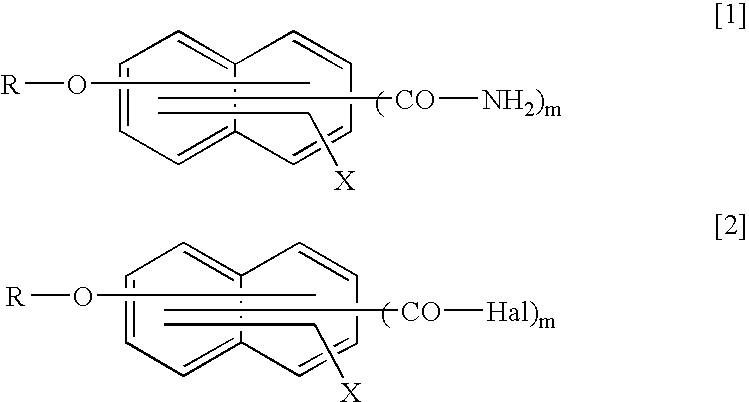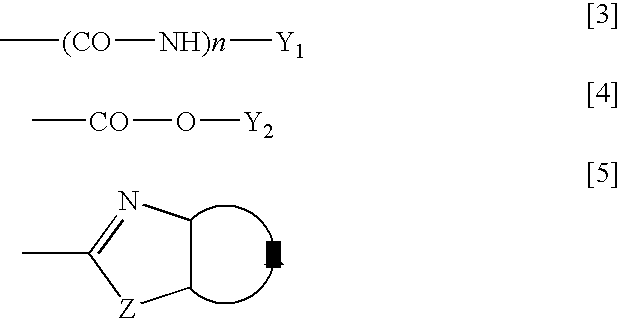Method for producing naphthalene carboxylic acid amide compound
- Summary
- Abstract
- Description
- Claims
- Application Information
AI Technical Summary
Benefits of technology
Problems solved by technology
Method used
Image
Examples
example 1
[Acid Chlorination Reaction]
[0093] 23. 1 g (0.1 mole) of 2-acetoxy-6-naphthoic acid, 0.1 g of N,N-dimethylformamide and 185 g of tetrahydrofuran were fed into. 300 ml-glass container. To this mixture, 23.9 g of thionyl chloride was added dropwise at room temperature under stirring. Then, the reaction was heated to 50° C. and kept at this temperature for 30 minutes. From the resulting mixture, tetrahydrofuran and the excess thionyl chloride were distilled out using a rotary evaporator to give 24.9 g (0.1 mole) of 2-acetoxy-6-naphthoic acid chloride.
[Amidation Reaction]
[0094] 15.4 g (0.2 mole) of ammonium acetate and 69.3 g of tetrahydrofuran were fed in 300 ml-glass container and the mixture was kept at 20° C. for one hour under stirring.
[0095] Then, 2-acetoxy-6-naphthoic acid chloride obtained by the acid chlorination reaction was dissolved in 115.5 g of tetrahydrofuran. The resulting mixture was added dropwise to the suspension of ammonium acetate in tetrahydrofuran over 15 min...
example 2
[Acid Chlorination Reaction]
[0097] The acid chlorination reaction was carried out in the same manner as Example 1 except that 18.8 g (0.1 mole) of 2-hydroxy-3-naphthoic acid was used instead of 23.1 g (0.1 mole) of 2-acetoxy-6-naphthoic acid and 94 g of tetrahydrofuran was used. 20.6 g (0.1 mole) of 2-hydroxy-3-naphthoic acid chloride was obtained.
[Amidation Reaction]
[0098] The amidation reaction was carried out in the same manner as Example 1 except that 2-hydroxy-3-naphthoic acid chloride obtained by the acid chlorination reaction was dissolved in 25 g of tetrahydrofuran.
[0099] The resulting reaction mixture was subjected to high performance liquid chromatography (HPLC). The yield of 2-hydroxy-3-naphthoic acid amide to the starting material, 2-hydroxy-3-naphthoic acid chloride, was found to be 77 mole %.
example 3
[Acid Chlorination Reaction]
[0100] The acid chlorination reaction was carried out in the same manner as Example 1 except that 24.6 g (0.1 mole) of 2-hydroxy-3-methoxycarbonyl-6-naphthoic acid was used instead of 23.1 g (0.1 mole) of 2-acetoxy 6-naphthoic acid and 123 g of tetrahydrofuran was used. 26.4 g (0.1 mole) of 2-hydroxy-3-methoxycarbonyl-6-naphthoic acid chloride was obtained.
[Amidation Reaction]
[0101] The amidation reaction was carried out in the same manner as Example 1 except that 2-hydroxy-3-methoxycarbonyl-6-naphthoic acid chloride obtained by the acid chlorination reaction was dissolved in 54 g of tetrahydrofuran.
[0102] The resulting reaction mixture was subjected to high performance liquid chromatography (HPLC). The yield of 2-hydroxy-3-methoxycarbonyl-6-naphthoic acid amide to the starting material, 2-hydroxy-3-methoxycarbonyl-6-naphthoic acid chloride, was found to be 72 mole %.
PUM
| Property | Measurement | Unit |
|---|---|---|
| Substance count | aaaaa | aaaaa |
| Fraction | aaaaa | aaaaa |
| Fraction | aaaaa | aaaaa |
Abstract
Description
Claims
Application Information
 Login to View More
Login to View More - R&D
- Intellectual Property
- Life Sciences
- Materials
- Tech Scout
- Unparalleled Data Quality
- Higher Quality Content
- 60% Fewer Hallucinations
Browse by: Latest US Patents, China's latest patents, Technical Efficacy Thesaurus, Application Domain, Technology Topic, Popular Technical Reports.
© 2025 PatSnap. All rights reserved.Legal|Privacy policy|Modern Slavery Act Transparency Statement|Sitemap|About US| Contact US: help@patsnap.com



